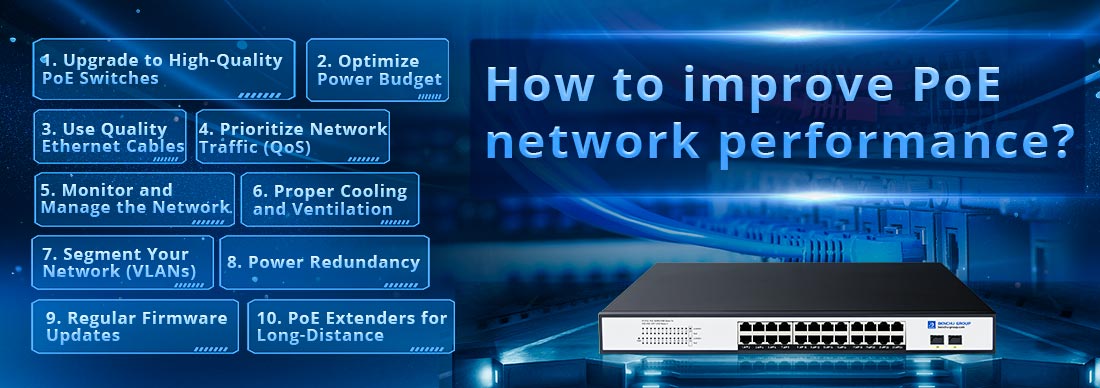
Improving PoE network performance involves optimizing both power delivery and data transmission to ensure that all devices connected to the network operate smoothly and efficiently. Here are several ways to enhance the performance of a PoE network:
1. Upgrade to High-Quality PoE Switches
--- Use managed PoE switches for better control over power distribution, monitoring, and traffic management.
--- Upgrade to PoE+ or PoE++ standards (IEEE 802.3at or 802.3bt) to support devices requiring higher power levels, ensuring future-proofing and compatibility with advanced devices like PTZ cameras or high-power wireless access points.
2. Optimize Power Budget
--- Ensure the PoE switch has sufficient power budget for all connected devices. Each switch has a maximum power limit it can provide, and exceeding this limit will cause performance issues. Choose switches with a higher power budget when scaling your network.
3. Use Quality Ethernet Cables
--- Upgrade to Cat6 or Cat6a cables if you’re using older Cat5e cables, especially for longer distances or when dealing with higher power devices. Higher-quality cables reduce signal loss and ensure stable data transmission.
--- Limit cable lengths to 100 meters (328 feet) or shorter to maintain optimal performance.
4. Prioritize Network Traffic (QoS)
--- Enable Quality of Service (QoS) on your PoE switch to prioritize critical traffic (e.g., video from IP cameras or VoIP calls) and prevent congestion.
--- Set bandwidth limits for non-essential devices to ensure vital services have uninterrupted connectivity.
5. Monitor and Manage the Network
--- Use the switch’s monitoring tools to observe power consumption, data traffic, and device status in real-time. Managed PoE switches typically offer detailed monitoring features.
--- Implement SNMP (Simple Network Management Protocol) for centralized monitoring and management across multiple switches and devices, ensuring proactive detection and resolution of issues.
6. Proper Cooling and Ventilation
--- Ensure that your PoE switches and other network devices are well-ventilated to prevent overheating, which can degrade performance.
--- In high-density setups, consider rack-mounted solutions with fans or temperature-controlled environments to maintain stable operation.
7. Segment Your Network (VLANs)
--- Use VLANs (Virtual Local Area Networks) to segment traffic, reducing broadcast traffic and improving overall performance, especially in large networks with many PoE devices.
8. Power Redundancy
--- Add redundant power supplies or use PoE injectors with backup power sources to ensure continuous power delivery even in case of power failure.
9. Regular Firmware Updates
--- Keep PoE switches and connected devices updated with the latest firmware to improve security, stability, and performance.
10. PoE Extenders for Long-Distance
--- Use PoE extenders or repeaters if you need to power devices that are beyond the standard 100-meter cable limit. This prevents voltage drop and data degradation over long distances.
By applying these strategies, you can maintain optimal data throughput and power delivery, ensuring that your PoE network runs efficiently and reliably, even as it scales.